by Allison Leo | Apr 29, 2022
Benefits of being recognized

Ways to feel special without food! Youth receiving rosette for a job well done!
One of the most important aspects of working with youth is the relationships that we build with them. Recognition is a basic human need, and in 4-H, recognition of youth members for their knowledge gained and mastery of skills is an important part of our positive youth development program. Using incentives and prizes during a 4-H program can be an effective way to create a sense of belonging. While working with youth, it is important to acknowledge their achievements and hard work throughout the club year.
Using Food as a Reward
Candy and sweets are often used to reward good behavior or accomplishments because kids like them and they are inexpensive. It is tempting to lean towards sweets and candy when selecting rewards and prizes for youth, but when food is given as a reward, children start to connect it to good or bad, and not fuel for the body. Rewarding youth with sweets can contradict the teaching and modeling of behaviors that promote healthy life skills in 4-H. Often, these foods have little or no nutritional value.
Non-food Rewards
Non-food rewards are a great option for acknowledging youth at 4-H club meetings, in school, and while at home. By using non-food rewards to acknowledge behavior, this promotes a healthy environment and helps children develop a healthy relationship with food. Recognizing youth with words of appreciation are better motivators than rewards of food. Telling a child, “I am so impressed with how hard you worked on your project,” is a healthy alternative to giving them candy for their success.
Creating an Inclusive Environment
Non-food rewards also create an inclusive environment for those we have food allergies and cannot partake in many food rewards. The Centers for Disease Control and Prevention’s (CDC) “Voluntary Guidelines for Managing Food Allergies in Schools and Early Care and Education Programs” recommends the “use of non-food incentives for prizes, gifts, and awards.” While a shift to non-food incentives may require slight changes to traditions, there are many potential benefits. Below is a list of free and low-cost reward options to use with kids.
Free
- Certificate
- Lead a game or activity
- Help teach lesson
- Trip to the park
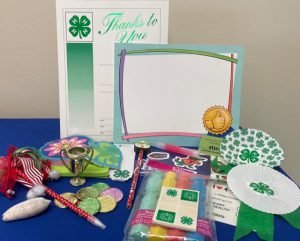
Examples of non food reward items.
- Special privilege at home or club meeting
- Book exchange
Low-cost rewards
- Stickers
- Stress balls
- Notepads
- receive a plant, seeds and a pot for growing
- Pencils
- Art supplies
- Coloring book g
- Glitter
- Bookmarks
- Cupcake Wrapper Rosette
- Small toys
- Stencils
Group rewards
- Bowling party
- Field day
- Movie day
- Trip to a community park
- Canoe or kayak trip
by Marie Arick | Feb 18, 2022

Mill Pond, Marianna, Fl. Photo credit Marie Arick
Grab your favorite soft cotton sweatshirt, jeans and those nice leather sneakers or boots … these all require agriculture! Kayaking in your favorite spring? Springs are considered a part of agriculture, labeled as a natural resource and are managed by the Florida Department of Environmental Protection.
Agriculture touches our lives daily. It would be quite impossible to navigate our world without the assistance of agriculture. Timber farms produce the lumber to build homes and make paper, cotton is used not only for clothing, but also in the creation of our paper monies. And we have not even discussed the foods we eat, and numerous other products created utilizing agricultural products.
Agricultural insight into the production and management of agricultural resources is why we in Extension promote and teach Ag Literacy. It is this basic knowledge that celebrates those who work hard daily to not only produce items to be consumed, but also manage those agricultural resources not only on the farm, but also our forests and waterways. This management can even rely on public policies for protection of these resources to ensure proper usage for generations to come.
Still not convinced? Did you wash your hair this morning and brush your teeth? Thank a farmer. Agricultural and the related industries contributed more than $1.1 trillion to the gross domestic product of the United States in 2019 and also provided 19.7 million jobs in 2020 per the U.S. Department of Agriculture. That is a small insight into how much agriculture impacts your life every day.
Everyone is dependent on agriculture in numerous forms each day. Celebrating Ag Literacy Day is a great way to expand your agricultural insight and awareness. Look around and appreciate the beauty of our land and waterways. Explore agriculture and all the ways to be a good steward of these natural resources, after all we all depend on them every day.
by Marcus Boston Jr. | Feb 4, 2022
My name is Marcus Boston and I’m the County Extension Director and 4-H Youth Development Agent in Leon County, Tallahassee FL. I’m originally from Gainesville Florida and have worked for the Leon County Extension Service as a 4-H Extension Agent, for 29 years.
I was born and raised in Gainesville FL., the location of the State 4-H office but was never involved in 4-H as a youth. I graduated from Buchholz High School in Gainesville Florida and earned a football scholarship to attend school and play football for Florida A&M University (FAMU) in Tallahassee. As a result of my accomplishments on and off the team, during my senior year, I was awarded the prestigious Alonzo Smith “Jake Gaither” Award. I completed my B.S. degree in Agribusiness and while working as a graduate assistant coach on the football team, I completed my M.S. in Agricultural Sciences. Prior to starting graduate school, I worked as a Sideline Commentator for the Florida A&M football games that were aired on a local radio station. After completing graduate school, I began my professional career as an extension agent with Florida A&M University and the University of Florida working primarily with 4-H Youth Development.
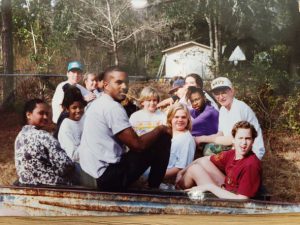
Marcus joins Leon County 4-H Leadership Club fun day activity in the early 90’s
When I started in Leon County one of my first assignments was to make a personal visit to all the existing 4-H clubs in the county at that time. After meeting all the wonderful volunteers and youth involved in our Leon County 4-H program, I was inspired by all the fun educational projects the youth were involved in and encouraged by the commitment and passion of the volunteers that oversaw the clubs. It is this commitment and passion that still exist today and that encouraged me to work extra hard to recruit and train volunteers so there could be more clubs for youth to join.
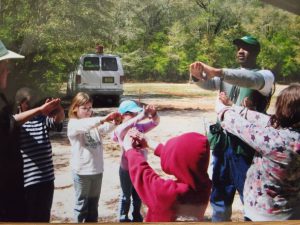
Marcus Boston teaching youth how to determine which eye is dominant before archery class
The establishment of my Environmental Education/Stewardship Program is one of my most successful programs here in Leon County. This program includes a series of smaller programs developed and carried out with the primary objective of educating our youth about the importance of conserving, protecting, and appreciating our environment and how they can become environmental stewards in their respective community’s. These experiences are tailored to equip youth participants with the information they need that will help them make logical decisions on environmental issues that may arise as they enter adulthood. In a few years these youth could be accountable for attitudes, perceptions and policies that affect our environment as well as our soil. A few of the environmental focused experiences that I developed and carried out during past several years as part of our Leon County 4-H program are: 4-H Ecology Field Day, 4-H Eco-ventures Spring Break Camp, Wild About Water Day Camp, The Talking Trash Day Camp, Going Green Day Camp, No Woods Left Behind Day Camp, Trees and Bows Day Camp, 4-H Wildlife and Outdoor Recreation Camp at Jubilee, and residential camp at 4-H Camp Cherry Lake held in Madison FL.
As a certified archery and canoe instructor, I’ve had the pleasure of teaching thousands of youth communications and safety skills using a canoe and a bow and arrow as the vehicle of choice. Both of which I’m still involved to this day. In an effort help young people learn the life cycle, I have taught the 4-H Embryology program in several schools in Leon County. This program has provided the opportunity for hundreds of students and teachers, to watch chicks hatch out of their eggs right before their eyes in their classroom…an experience they never forget.
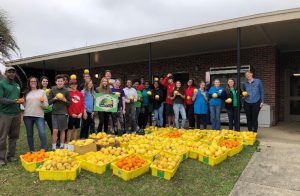
Leon County 4-H Camp Counselors kickoff counselor training with gleaning 1,300 lbs. of fruit to provide for homeless shelter
The Leon County 4-H Camp Counselor Training Program has also served as one of my most successful teen leadership programs. I have enjoyed recruiting, training and equipping hundreds of teens with the skills and knowledge they need to: Manage campers at our residential camp, understand the “ages and stages” of the youth they supervised, apply strategies for teaching classes at camp, and most important, keeping camp safe for all in attendance. Due to the success of this program, former counselors from our counselor training program are viewed and recruited as potential camp staff for our State 4-H camps each year.
I have also enjoyed providing opportunities for thousands of youth in Leon County Schools to participate in The 4-H Tropicana Public Speaking Program (now known as the Florida 4-H Public Speaking Program sponsored by Florida Power and Light) which annually provides an opportunity for over 7,000 Leon County 4th, 5th, and 6th graders to develop, write, and present a speech on a topic of their interest. With so much emphasis on texting and posting…this program continues to provide a platform for young people to develop their oral communication skills which is crucial as they graduate and enter the work force.
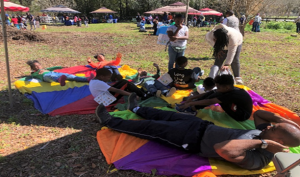
Marcus Boston is demonstrating fitness techniques with attendees during Youth Extension Day in Leon County.
I have also been a Project Learning Tree(PLT) facilitator for over 20 years and have help to train over 500 college students from Florida State, Flagler College and Florida A&M University in how to teach youth environmental education using the PLT curriculum.
The last six years as County Extension Director has provided me an opportunity to promote UF/IFAS Extension by managing and working with my faculty in providing researched based information in the form of workshops, field days, 4-H clubs, seminars, virtual and hybrid webinars and school enrichment programs in an effort to help youth and adults in the Leon County Community find the Solutions For Their Life. I have always believed that active participation in 4-H provides youth the tools in life to be successful in whatever direction they choose to go.
by pmdavis | Feb 2, 2022
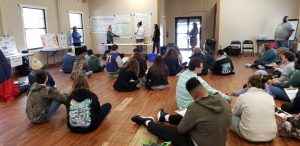
Youth at teen retreat learning about financial literacy
The Northwest District 4-H Teen Retreat registration will close Feburary 7th. The actual event will be 25-27 @ Timpoochee 4-H Center. This weekend features leadership building and fun workshops for 12-18 years old youth.
Register NOW in 4honline for the NWD 4-H District Teen Retreat at 4-H Camp Timpoochee.
Friday’s Schedule
6:00-7:15 pm – Check-in & pizza
7:15pm – Welcome & District Intros
8:00 pm – Campfire
Saturday’s Schedule
8:30am – Breakfast
9:15am – Group Pic
9:30-11:30am – Workshop Sessions
12:00pm – Lunch
1:00-2:45pm – FUNshop Sessions
3:00pm – Rec Time – 4-Hers vs Agents Kickball & Nine-Square
5:00pm – Service Project
6:00pm – Dinner
7:00pm – District & State Events Reports
7:30pm – Dance, Games & Snacks
9:00pm – Music, Campfire & Smore’s
Sunday’s Schedule
7:00pm – Rise & Shine, pack-up
When I ask the youth that attended previously what they got out of the program? They said they learned how to interview for a job, how to write a resume, and find college scholarships. Another teen said, I met really nice people from other counties and how to decorate cakes. A third memeber said she learned how to start managing her money.
For more information contact your 4-H Agent. We can’t wait to see you at the 2022 NWD 4-H Teen Retreat!
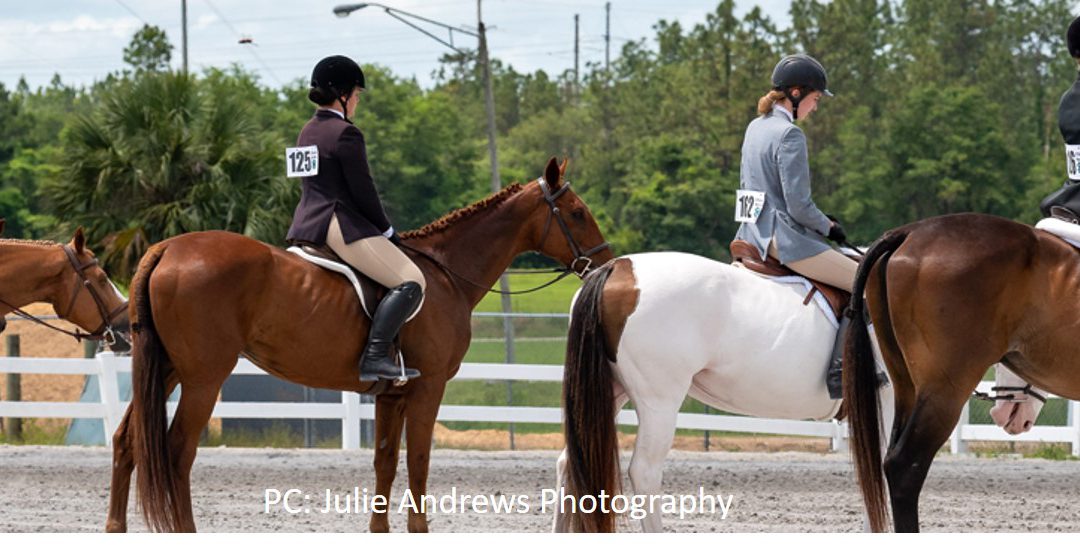
by aschortinghouse | Jan 15, 2022
While the Florida 4-H Horse Program is

4-H Youth participating at Area Horse Show.
composed of many opportunities, one of the most well-known opportunities is the Area and State horse shows. Each county in Florida is assigned to a specific Area, which hosts shows as a qualifier to the state show. Area North encompasses the whole of north Florida stretching from the panhandle to the coast down to Alachua. Below is some key information and important dates for the 2022 Area North show year.
Important Dates
- March 14 – April 1: Area North Registration, no late entries are accepted
- April 12, 5:30 CST/6:30 pm EST: Horse Show Virtual Prep Night on Zoom
- April 29 – 30: Area North Horse Show, Green Cove Springs, FL
- July 6 – 9: State Horse Show, Tampa, FL
Key Changes for the 2022 Horse Show
- Multi Horse Projects & Showing. All youth may now show multiple horses even at the State level. All horses must be certified project horses by Jan 1. Each rider/horse combo will be scored as a unit for points. No horse or rider may enter the same class as multiple entries.
- Walk Trot is coming to Area North! All walk trot classes are non-point classes. Youth may only compete in walk trot classes for two years- per horse/rider combination. Exhibitors entered in a walk trot class may not cross over into any loping or cantering class. If a walk trot exhibitor qualifies for the State 4-H Horse Show with points from in-hand classes, the exhibitor’s county 4-H agent will need to approve their advancement to the State 4-H Horse Show. Walk trot exhibitors will only be eligible to enter in-hand classes at the State 4-H Horse Show.
- Dressage tests are now “test of choice”.
- Saddle Seat & Gaited division are now gone; however, these type horses can still be shown in comparable classes.
- Sportsmanship Award Continued!
- Introducing, the “Crew”! Crew is an opportunity for horseless or non-showing youth to still be involved in clinics and horse shows by offering their skills in organization, grooming, cheering, and more. Crews are by-county, and their specifics may vary.
- Record Books are a critical component of your horse program year. We have record books for both riding and non-riding participants. Seniors are encouraged to use the NEW SENIOR Horse Record Book, especially if they intend on applying for the Horseman of the Year Scholarship. Juniors and intermediates may use the existing version. Additionally, your county may have its own version. Check with your agent to complete this part of your program. To find out more visit: https://animal.ifas.ufl.edu/extension/youth/horse/horse-record-books/
To stay up to date with everything Area North, follow us on our Facebook page at UF IFAS Extension 4-H Area North Horse Program.
This blog was authored by the following individuals:
Kelsey Irvine, UF/IFAS Nassau County, 2022 Area North Chair
Allie Anderson, UF/IFAS St. Johns County, 2022 Area North Vice Chair
Aly Schortinghouse, UF/IFAS Escambia County










